Most films or TV programmes betray the time of their making in some way. Sometimes, it’s an obvious stylistic tick. Sometimes it will be a cultural quality unrecognised at the time, and sometimes it will be the constraints or opportunities of technology. Watch any TV archive footage or old movie and the clues are hard to avoid: those garish, primary-coloured ads of the 80’s; the specific fashions of a decade leaking into a costume drama; smoked filled rooms are as much of a giveaway as badly ageing special effects. All these visual clues mean you can make a reasonable stab at guessing when they were made. A new date-defining element has become a screen icon of recent months – the video call. In the midst of a health crisis, with lives at stake and with necessity in command, it’s hard to see whether it will be a passing thing or with us as the new normal.
Almost from the first social-distancing restrictions of the pandemic, video calls have replaced conventional interactions. Television news and current affairs programmes instantly switched to ‘Skyping’ interviews from contributors. Families and friends retained contact through ‘Facetime’. ‘Zoom’ became standard practice in business meetings and tutorials. None of this technology was new but its use had been relatively niche; it remained a poor substitute. Now, however, it has not just allowed some aspects of life to function, it has displaced some of the old ways of doing things altogether. The question is, will we go back to how it was, or will these changes be permanent? Will video calls ‘date’ a particular year or two, or will they mark a new era: BC or AC – Before Covid or After Covid?
I’ve been making short videos for the BBT for almost 20 years and we’re currently putting the finishing touches to a profile movie on Alessio Pianelli and his forthcoming CD. This will be our first production where I haven’t set foot outside my workroom to make it. A trip was planned to Sicily to shoot Alessio in the landscape and cultural setting that has inspired his music-making. Our planning for these trips is often quite loose – there will be a list of arranged events and locations – but generally they are trips of discovery which are pulled into a narrative in the edit.
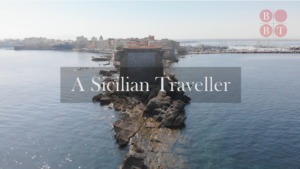
The start of Graham Johnston’s BBT film about Alessio Pianelli’s A Sicilian Traveller
But as Italy first, and then the rest of Europe became engulfed in the pandemic it become obvious that we would not be able to travel. Alessio had access to some video of a recording session for the CD in Rome and could arrange for local videographers to shoot new material in Sicily. An interview could be recorded via Zoom and stills and mixed audio tracks from the CD could be used as normal. So, almost without hesitation, the decision was made to make the video within the new constraints. Any compromises in technical quality would be balanced by the fact that we were still accessing the essential elements that drive all our videos and that for us as video-producers and for our viewers on the BBT YouTube channel and, here, on the BBT website, this would still be a journey of discovery. Within a few weeks, Alessio had organised some filming in Sicily and arranged to send us footage from the CD recording session in Rome.
Video calls are something the world will get better at, but by necessity they will always compare badly to forms of photography where someone is operating the camera. The fact that a video call camera is fixed on a device sitting on a table, be that a laptop or desktop computer, or is even in a mobile device, means that there is often little scope to compose an image. The best that can be done is to make sure nothing distracting is in the background and that there is enough light on the subject’s face. As a camera person you can choose the position of a camera so that light is favourable and choose a background which helps give a sense of space and place. With a little experience you can make good predictions about these choices and interviewees will be unaware that the requests being made about where they sit, or to move their chair a few centimetres are to improve the framing of shot. Such adjustments, when made over the internet, with interviewer, interviewee and video-maker hundreds of kilometres from each other, make over-bearing demands when time is short, and when the priority is on getting what is said rather than how it looks.
In other words, if it’s not distractingly bad, it will do.
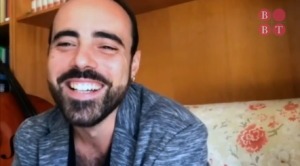
Alessio Pianelli on Zoom
So, with the ‘shoot’ for A Sicilian Traveller, Alessio was set up in a nice looking room with some bookshelves and a good daylight source in front of him. Sound was now my biggest problem. Broadband connections can vary in quality – even within a call – and can be a little glitchy. They can sometimes freeze for a fraction of a second or distort into digitised ‘robot voice’ noises. Even if Alessio had a high-quality external mic to plug in to his desktop computer this would have been a problem. I’m something of a stickler for good, clean audio – more so than pictures – and this would not do. Our solution was for Alessio to record the interview on his iPhone while I recorded the Zoom conversation on my computer. Alessio would then send me the audio file he’d captured and I’d sync up his glitch-free words to the pictures recorded in the Zoom call.
With physical equipment, there’s always the possibility of mechanical failure along with human error but in interview shots, retakes are rare. Somehow, our virtual recording session – with each of us in different parts of Europe – was more nerve-racking because all the connections and most of the means of monitoring them were invisible or out of reach. Again, in normal times, I would be in the same space as Alessio and if there were problems or adjustments required to improve the technical or artistic, I can simply step in and try something out. Every problem on a video call has to be diagnosed and sorted remotely with the added barrier of language.
The interview recording with Nick Breckenfield went well and Alessio coped with the added responsibility of recording his end of the call. By the end of the fascinating conversation and a quick check that it was safely recorded, we knew we had what we needed and any dissatisfaction with the technical limitations were quickly overcome by the relief that we had captured footage while remaining almost 2,000km apart. Internet technology had placed us all in the same virtual room and we had the content ‘in the can’ that the Covid-19 pandemic had threatened to make impossible.
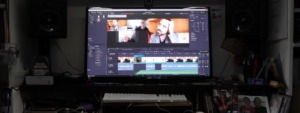
Graham Johnston’s work station
The next footage we needed – music and setting – would ordinarily be the determining factors in deciding when and where we shoot a BBT video. Usually, we base a shoot around a musical event, arrange some time for an interview, and then allow time to get ‘general view’ shots to help thread a story that is located in a particular time and place, but which will have relevance across many years. These things, as a video-maker – the specific and the more timeless – are always at the back of my mind when selecting shots and action. Meaning is often revealed to us as the shoot progresses. By this, I mean that we don’t go into any shoot with a check list of things we want to say. Our starting point is usually with the thought that ‘there’s something significant here’ and the video-making process is about finding it. It’s something I hope we’ve achieved in all the 60+ movies that we’ve made for the BBT.
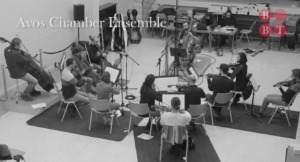
Avos Chamber Ensemble, Rome 2019. Photo Santi Peralta
This element, of ‘finding’, of course, was not available to us in this case. All the footage of music-making and location would be ‘given’. Getting a sense of the island on video, as well as samples of music performance, was an essential part of what we were looking for. Fortunately, the video-makers Alessio had employed to get footage for us were highly competent and gave us stunning drone shots of Trapani, and artful shots of Alessio playing his cello in dramatic locations. Video footage of the recording session in Rome gave us the kind of ensemble images and close-ups that get the viewer close to the music making. With all the clips now assembled it was time to start editing.
In every production, there’s a shift when all the things that seemed like good ideas at the time, don’t seem likely to fit together. The editing process is almost always one of giving up on what you hoped or planned to do, and then starting all over again. When you’ve filmed everything yourself, there’s usually an unconscious thread through it – some consistent curiosity, some hidden and unplanned continuity or pattern in the action in front of the camera – that guides shot selection or framing and then emerges in the edit. This latent presence is, perhaps understandably, easier to find when it is your own footage you are working with.
What’s been a pleasure about working with other people’s footage is that it is both liberating and constraining. One of the key liberations is being free of self-criticism – the ‘if only I’d done that differently’ syndrome. With third-party footage it’s much easier to select the clips you like and which might have value, because you can simply use your responses as a new viewer; if it elicits a response, it goes into the clip selection ‘folder’ as potentially useable. Oddly, as videographer and someone with a visual arts training, I tend to begin the editing process with the words. Once I have a spine of verbal meaning then the visual structure and counterpoint comes into focus. It’s also the stage at which obstructions to opportunities become apparent. This is not, though, a point of despair; it is much more the stage where the creative juices really start to flow.
One such obstruction emerged in the video footage from Rome – these shots of the recording were often too short to use and the audio was recorded through the camera mic. When I shoot performance footage I’ve learned to let the camera run on so that I can, for example, pick a good moment of playing for the edit and have plenty of ‘spare’ audio to lay under explanatory speech from a contributor which might be on either side of it. This option wasn’t available with the Rome clips so I had to find another solution. In fact, two were successful: slowing footage down; and, grabbing stills which were then zoomed and panned across. This meant we could add selections from the CD mix and avoid picture-sync issues and also had a visual effect which, hopefully, draws the viewer into the music-making without being too tricksy. Similar thinking was applied to the Sicily footage because it was also being used in a beautifully produced and edited music video to promote one of the CD tracks and I didn’t want to simply ‘lift’ this footage directly from that finished movie. In both cases, the constraint led to something new and a way of revealing what is significant that I would probably never have tried with my own footage.
Is this then, the way to work in the future? Will the pandemic create a stylistic bubble of Skype-calls and third-party video we associate with 2020/21 – or is 2020 a dateline BC or AC?
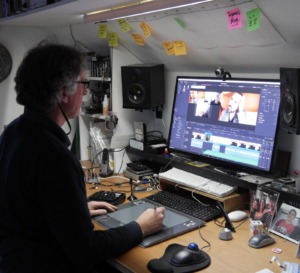
Graham Johnston in his studio
I think the reality will be somewhere in between. In spite of the tragic loss of life and economic damage, the Covid-19 pandemic may yet teach us useful lessons. Among them, that easy global flying is a luxury we can ill-afford and that production quality is not an end in itself; it’s what is communicated and shared that is important. Zoom-calls and their ilk will be a part of our media and communication landscape from now on – the pandemic has broken down resistance to a second-preference form of contact through necessity. They will surely now be a regular option if logistics and availability make ‘seeing’ someone otherwise difficult or impossible. But I suspect their value will wane over time and they may never become our preference. The virtual collapse of ‘business as usual’ systems and modes of how we use our time and the societal collateral damage that has followed it, may yet remind us of the importance of the here and now and what makes that vital.
That contact with others in the here and now is what I have most missed in this year of pandemic. Yes, there has been plenty of time to reflect in one’s own locked-down, private space. But I am looking forward to the next opportunity to explore with a camera. The pandemic has opened up new ways of working which I’m sure will find their way into my practice – and more than just as a standby or emergency cover. But the obstructions I yearn for are those that come about in the here and now of discovery.
Watch A Sicilian Traveller here
Listen to excerpts from A Sicilian Traveller here